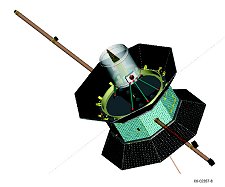Sentinels
Full Name: Sentinels
Phase: Under study
Launch Date: TBD
Mission Project Home Page: http://lws.gsfc.nasa.gov/missions/sentinels/sentinels.htm
Program(s): Living With a Star
The primary scientific objective of the LWS Sentinels element is to discover, understand, and model the connection between solar phenomena and interplanetary disturbances, particularly those impacting geospace. The Sentinels scientific objectives provide a natural coupling between the solar and geospace segments of LWS. The Science and Technology Definition team report was published in September 2006.
NASA’s Sentinels mission is a multispacecraft mission that will study (1) the acceleration and transport of solar energetic particles (SEPs) and (2) the initiation and evolution of coronal mass ejections (CMEs) and interplanetary shocks in the inner heliosphere.
Sentinels observations will be supplemented by observations both from other spacecraft such as the Solar Terrestrial Relations Observatories (STEREO), the Solar Dynamics Observatory (SDO), and Solar Orbiter and from ground-based observatories such as the proposed Advanced Technology Solar Telescope as well as existing radio and optical telescopes. Theory and modeling will play an integral role in the Sentinels mission during both the development and operations phases of the mission.
As presently envisioned, the Sentinels mission comprises:
- a constellation of four identically instrumented Inner Heliospheric Sentinels to make in-situ measurements of the plasma, energetic particle, and fields environment as close to the Sun as 0.25 AU as well as multipoint remote-sensing observations of solar X-ray, radio, gamma-ray, and neutron emissions
- a Near-Earth Sentinel in Sun-synchronous orbit for ultraviolet and white-light observations of the corona
- a
Farside Sentinel in heliocentric orbit at 1 AU to measure the
photospheric magnetic field from positions 60° to 120° ahead of the
Earth. During the 3-year nominal mission,
Sentinels is a key component of NASA’s Living With a Star (LWS) program and as such is designed to advance our knowledge and understanding of those processes and phenomena in the space environment that can adversely affect life and society.
The Sentinels mission is of particular importance to efforts to characterize, understand, and eventually forecast the radiation environment that will be encountered during human expeditions to the Moon and Mars.

